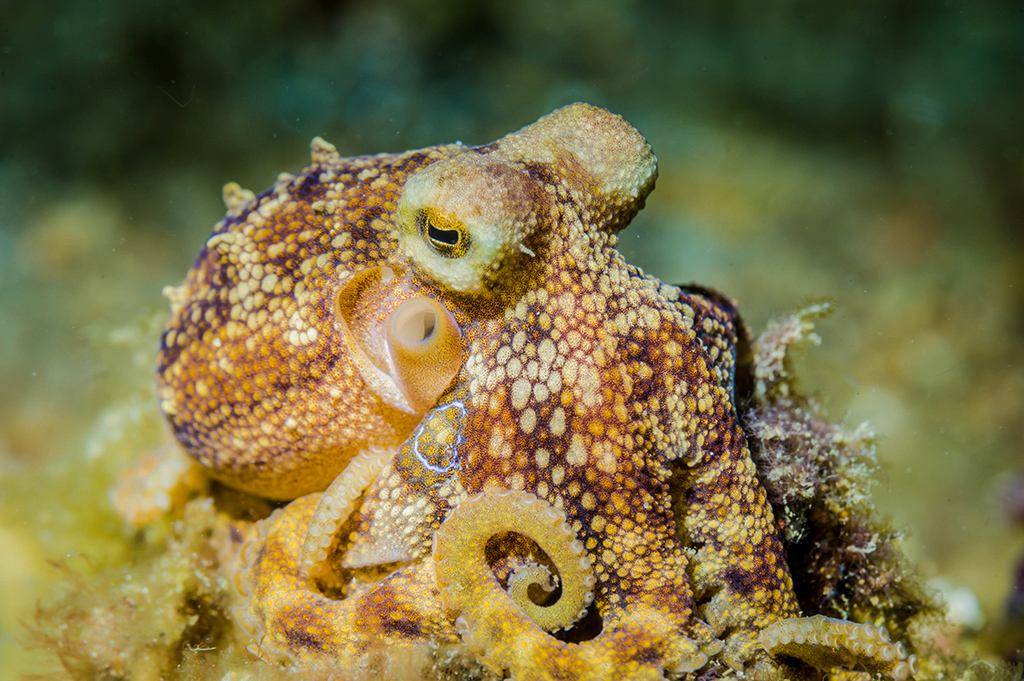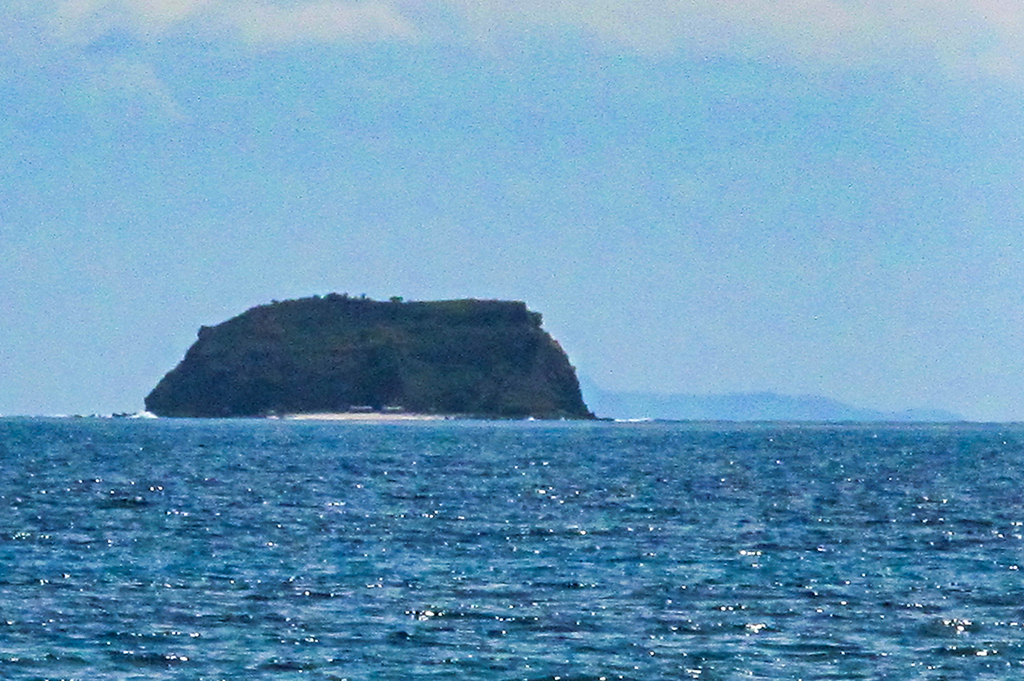
Descend Into Sombrero Island’s Tubastraea Heart

“The ocean is everything I want to be: beautiful, mysterious, wild and free.” ~ Anonymous
Okay, this is our third column. How are we doing so far? We received a request for a scuba diving destination piece, so without further ado, I’ll share with you one of our favorite off the beaten path dive sites. In 2006, international marine scientists proclaimed the Philippines as being the center of marine biodiversity in the world, surpassing even the Great Barrier Reef of Australia. In an archipelago with more than 7,000 tropical islands, Sombrero Island is one tiny isle that definitely stands out in a crowd.
Sombrero Island in the Morning
For several days, Kathryn and I had been gazing longingly at a hat-shaped island from Dive Solana Resort’s expansive compound. It felt as if Sombrero Island was calling to us, but we were being held back from making a dive there due to its exposed location and some rather impressive white-cap wave action generated by storm winds courtesy of a typhoon lurking ominously offshore from the Philippines. Aptly named because it’s unique shape resembles that of a Mexican sombrero, this uninhabited island, situated off the eastern tip of Tingloy Island in Batangas province, is known as being one of the best places for diving, or snorkeling, in the Philippines Anilao Batangas Marine Park Sanctuary. On the morning the weather improved, we departed early to go for a splash as wave action and currents tend to be strongest at Sombrero Island in the afternoon.
Fueled with anticipation, all the scuba divers onboard double-checked their underwater camera settings as our diving “Banca,” a traditional Filipino boat, nudged itself closer to Sombrero’s northern shoreline to drop anchor. Stiff surge pushed and pulled us around the moment we slipped beneath the waves. Once we descended closer to the seafloor, things settled down somewhat as we were able to use Sombrero’s numerous gullies and coral heads as cover from the liquid headwinds. Indeed, we were informed the diving here can be tricky at times due to ripping currents and formidable undertows that may flow from any direction; but occasionally there is no current. Yet, we felt quite at ease exploring Sombrero’s shallower coral depths amid the dense swarms of anthias frolicking in the water column.
Birthplace of Scuba Diving in the Philippines
“I love all the unique things you see on each dive. Millions of little aquatic soap operas playing out between all the creatures. And the silence. Well, it’s not really silent down there, but the roar of bubbles blocks any other sound.” ~ Kirsten Hubbard
Sombrero Island’s current-swept hat rim stretches from north to south underwater and is crisscrossed with wide gullies and immense coral heads. Tubastraea cup corals, also known as sun corals, with their striking yellow polyps and pink bodies, carpets the reef terrain. Ocean currents nourish these colorful hard corals, which in turn attracts large schools of trevallies, jacks, tuna and rainbow runners. Reef fish species include triggerfish, lionfish, batfish, giant frogfish and several species of rays. While it is always possible for some big pelagics to swim by, these encounters are unfortunately never guaranteed. Among the barrel and vase sponges, there are soft corals and a spectacular range of nudibranchs. Multi-colored feathery crinoids are seemingly scattered everywhere.
Viewed by many as being the birthplace of scuba diving in the Philippines, Anilao’s dive sites have earned a world-wide reputation for macro diving. Indeed, there is an impressive assortment of exotic reef critters at Sombrero Island, so at times it pays to simply stay in one place and search every nook and cranny for rare and unusual species. For those seeking some all out muck diving to strike some marine life such as mototi octopus, Zanzibar shrimp or solar-powered nudibranchs off their critter bucket list, you’ll find them in spades at nearby dive sites in Batangas Bay or Balayan Bay. Both these large bodies of water match up favorably against the exotic marine biodiversity one can find another world-famous muck diving destination, Lembeh Strait in Indonesia. Having done exploratory dives in both places, I can confirm the seafloor in Batangas Bay is littered with far less trash, and the underwater visibility is much clearer at Anilao’s dive sites than it ever was in Lembeh Strait.

About the size of a golf ball, the Poison Ocellate Octopus, aka Mototi Blue Ring Octopus, is said to be somewhat rare and has enough venom to kill 20 men, which is 10,000 times more toxic than cyanide. The toxin causes motor paralysis and respiratory arrest within minutes of exposure, leading to cardiac arrest due to a lack of oxygen. The likelihood of ever being bitten is also rare if you don’t pick them up.
Sombrero Island is often mistakenly assumed to be part of Anilao because diving tours depart from there. Sombrero is deemed to be an uninhabited island, but is also visited by day trippers who want to chill on its white sand beach. As the island is privately owned, there are also fees to be paid if you wish to go ashore and use any of the available huts and tables.
Sorry… Temporarily Closed?
In April 2018, Sombrero Island was closed to tourists upon orders of the San Pascual municipal government, over violations of environmental laws being broken. Yes, this iconic island happens to be a sanctuary and a natural hatchery for hawksbill sea turtles. Hence, only a part of this small island is allocated for tourist activities, but the rest of the island requires no human activity. Apparently, an illegal permanent structure had been constructed on the island by a family residing there, which is a clear violation of government rules for this protected area. Local authorities have stated Sombrero Island will reopen to tourism once the various violations, including those having to do with improper waste disposal regulations are complied with. So, be sure to check with your dive resort to see if the island closure has been lifted?
Sombrero Island’s Tubastraea Heart
“The sea, once it casts its spell, holds one in its net of wonder forever.” ~ Jacques Cousteau
Whenever shimmering rays of sunlight pierces Sombrero Island’s depths, there are few places we have dived in the Philippines that compare to its beautiful hard coral gardens. Thanks to brimming with swim-throughs and often exceptional visibility, underwater photographers can easily shoot either wide angle, or macro subjects here due to the sheer abundance of marine life species. Apparently, if you descend deeper in places at Sombrero you will come across some undersea caves. Gin-clear warm water mixed with a mind-blowingly beautiful reef-scape makes this corner of the Philippines a true scuba diver’s paradise. In retrospect, we think we only gently felt the pulse of Sombrero Island’s Tubastraea heart.
Until our next dispatch, dare to Explore…Dream…Discover.
Sombrero Island Scuba Diving Operators
Most all of dive resorts in Anilao will visit Sombrero Island when tide and weather conditions are just right. Anilao is just a two to three-hour drive from Manila, the capital of the Philippines. To reach Sombrero Island, it will take you 15 to 30 minutes by boat from the dive resorts. Travel time will vary depending upon weather conditions and how calm or rough the sea conditions are.
Overall, divers can anticipate good visibility and water temperatures requiring only a dive skin to a 3mm wet suit. Diving season is optimal between November to May. June to October is the rainy season and is also known for typhoons. Rain will generally cause a decrease in underwater visibility and in places can bring about storm warnings that prohibits diving for several days.

Dive Solana Dive Resort shore front with Sombrero Island off in the distance on the right side of this image.
Dive Solana Resort
Address: San Teodoro, Mabini, Batangas, Mabini, Batangas, Philippines
Website: divesolana.com
Email: info@divesolana.com










































